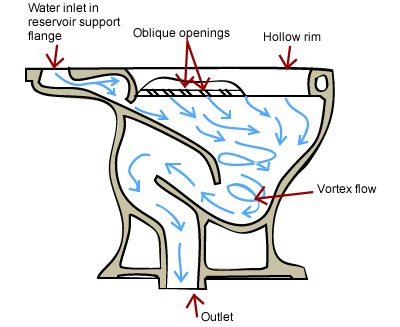
It’s almost impossible to tell how good a certain toilet will be just by looking at it. All kinds of factors affect how well a toilet flushes, including:
- the amount of water used in the flush
- the amount of waste a single flush will remove
- the height from which the water drops from the cistern into the bowl (particularly in gravity-fed systems)
- the gauge and design of the piping, and
- whether or not the cistern is pressurised.

In most cases, if you’re buying a modern toilet you shouldn’t have any big issues as far as performance is concerned. Most toilets are capable of handling more than the average load, and advances in water saving technologies mean that even water efficient cisterns can generate more than enough force to properly clear the toilet on the first flush.
As a rule, it’s important to make sure the cistern you buy is designed to work with the toilet bowl you buy – most often this means buying two of the same brand and product line. If you’re in doubt or if you have any special circumstances that you think might affect how well your toilet flushes, your best bet is to talk to an experienced retailer.
WELS and MaP ratings
There are some ratings that are applied to toilets which can help you determine how well a toilet will perform. These include the Water Efficiency Labelling and Standards (WELS) rating, and the US based Maximum Performance (MaP) rating. The latter isn’t common in Australia, but you may find some models which report this information.
Since most toilets are gravity fed dual flush systems these days, the WELS rating can help you determine how efficient at saving water a certain toilet will be, as well as how much water is released per flush. The higher the star rating, the more water efficient the product is going to be. A four star rating on a dual flush toilet for example, will amount to 4.5 litres on full flush and 3 on half flush (even though it isn’t exactly half).
The MaP rating involves much more testing and indicates the total amount of waste matter a toilet can dispose of within five flushes. The tests simulate real toilet use with soybean paste. Ratings range between 250 – 1000 grams, with the US standard being set at 350. Because this rating isn’t common here though, it can’t really be relied on as a point of comparison.
Performance of gravity fed toilets
Since gravity fed systems rely on a siphon effect to remove the waste material, the gauge and angles of the outlet piping will play a significant role in the toilet’s performance. The siphon effect is created when the flush quickly fills the toilet bowl with water, pushing all the air out of the pipes. This causes the water to get sucked down the pipe to even out the pressure. The effect ends when the water level falls below the first bend of the waterway, allowing air back in. Smaller waterways will create greater suction, but can increase the chance of blockages occurring so this needs to be taken into consideration too if you’re keen to get the best performing toilet available. The toilets with the best performance are the ones that can maintain the suction effect the longest, and this is typically a matter of design, and often a closely guarded trade secret.
Performance of pressure assisted toilets
Pressurised toilets do not use a siphon and rely only on the pressure stored in the water cylinder to push the waste down the pipe, so it’s easier to determine how effective each model is. The higher the pressure it can push out, the better it’s going to flush. These toilets generally have higher MaP ratings in US tests, so it can be safely said that they generally perform better than gravity fed toilets but it is still somewhat difficult to objectively compare the two.
What performance really means
With the introduction of water efficient toilets, it’s become more important than ever to stress that toilets are for human effluent waste only. Hair, feminine hygiene products, food scraps and other materials should never be flushed down the toilet. Doing so can quickly lead to clogging in your drains (especially when using a water efficient toilet), which has the potential to be a very unpleasant thing.
Having said that, provided that you use your toilet for what it’s designed for, you’re unlikely to have any great issues with modern systems. The vast majority of toilets are designed to handle plenty more than the average load, and provided that you treat them well and use them correctly, they should perform well within your expectations. If you have any doubts or need to know more about a specific model, discuss your concerns with a retailer or plumber.




